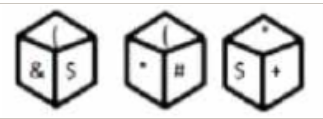Of a cubical container, different symbols indicating the position of instruments on all six sides are given. Which symbol is exactly apposite to c?
एक घनीय कंटेनर के सभी छः फलको में अंदर पैक किए गए उपकरणों की स्थिति को दर्शाते हुए भिन्न-भिन्न चिह्न अंकित किए गए हैं। कौन-सा चिन्ह C के पीछे हैं ?

Z
B
X
Y
The correct Answer is:A
Step by step video & image solution for Of a cubical container, different symbols indicating the position of instruments on all six sides are given. Which symbol is exactly apposite to c? एक घनीय कंटेनर के सभी छः फलको में अंदर पैक किए गए उपकरणों की स्थिति को दर्शाते हुए भिन्न-भिन्न चिह्न अंकित किए गए हैं। कौन-सा चिन्ह C के पीछे हैं ? by Reasoning experts to help you in doubts & scoring excellent marks in Class 14 exams.
Updated on:21/07/2023Similar Questions
Three different positions of the same dice are shown below. Which symbol is on the face opposite the face showing ‘(’
एक पासे के तीन पद दिए गए हैं | निम्नलिखित में से कौन सा चिन्ह '(' के विपरीत आएगा ?
View SolutionTwo different positions of the same dice are shown, the six faces of which are marked by the letters A B, C, D, E and F. Which letter will be on the face opposite to the one showing 'D'?
एक पासे के दो पद दिए गए है| पासे पर अक्षर A,B, C, D, E, F लिखे हुए हैं | D के विपरीत कौन सा अंक आएगा ?
View Solution
Knowledge Check
Below are given two/three statements followed by two conclusions numbered I and II. You have to take the given statements to be true even if they seem to be variance with commonly known facts. Read all the conclusions and then decide which of the given conclusions logically follows from the given statements, disregarding commonly known facts. Give answer:
Statements : All blocks are stones. All stars are stones.
Conclusions : I. All blocks are stars. II. Some stones are stars.
नीचे दिए गए प्रश्न में एक/दो कथन और उसके बाद निष्कर्ष I और II दिए गए हैं। आपको दिए गए कथनों को सत्य मानना है, भले ही वे सर्वज्ञात तथ्यों से भिन्न हो। फिर तय कीजिए कि कौन-सा निष्कर्ष दिये गये कथनों का तर्क संगत रूप से अनुकरण करता है, चाहे सर्वज्ञात तथ्य कुछ भी हो। अपने उत्तर दीजिए:
कथन :सभी टुकड़े पत्थर हैं। सभी तारे पत्थर हैं।
निष्कर्ष : I. सभी टुकड़े तारे हैं। II. कुछ पत्थर तारे हैं।AIf only conclusion I followsBIf only conclusion II follows.CIf either conclusion I or II followsDIf neither conclusion I nor II follows.Directions : Study the following information and answer the questions given :
Seven people - A, B, C, D, E, F and G are sitting in a circle. Five of them are facing the centre while two of them are facing opposite to the centre. C sits third to the left of D and both are facing the centre. E is neither an immediate neighbour of D nor of C. The one sitting exactly between D and F is facing opposite to the centre. G sits third to the right of A and G is facing the centre. One of B's neighbours is facing opposite to the centre.
सात लोग- A, B, C, D, E, F और G एक वृत्ताकार घेरे में बैठे हैं। इनमें से पांच केन्द्र की ओर मुंह किए है जबकि इनमें से दो केन्द्र के विपरीत मुंह किए हैं। C, D के बाएं तीसरे स्थान पर बैठा है और दोनों केन्द्र की ओर मुंह किए हैं। E न तो D का निकटतम पड़ोसी है न ही C का। वह जो ठीक D और F के बीच बैठा है केन्द्र के विपरीत मुंह किया है। G,A के दाएं तीसरे स्थान पर बैठा है और केन्द्र की ओर मुंह किया है। B का कोई एक पड़ोसी केन्द्र के विपरीत मुंह किया है।
निम्नलिखित में से कौन-सा जोड़ा ऐसे व्यक्तियों को दर्शाता है जो केन्द्र के विपरीत मुंह किए है?AA and F / A एवं FBE and F / E एवं FCA and E / A एवं EDCan't be determined / निर्धारित नहीं किया जा सकताStudy the following information carefully and answer the questions given below:
A, B, C, D, E, F, G and Hare sitting around a circle facing at the centre. F is third to the right of B who is third to the right of H. A is third to the left of H C is fourth to the left of A. E is third to the right of D who is not a neighbour of A.
Who is second to the right of D?
निम्नलिखित जानकारी को ध्यानपूर्वक अध्ययन कर नीचे दिए गए प्रश्नों के उत्तर दीजिए:
A, B, C, D, E, F,G और H केन्द्र की ओर मुंह किए एक वृत्त के गिर्द बैठे हैं। F, B के दाएं तीसरा है जो H के दाएं तीसरा है। A, H के बाएं तीसरा है। C, A के बाएं चौथा है। E, D के दाएं तीसरा है जो का पड़ोसी नहीं है।
D के दाएं दूसरा कौन है?AFBGCADNone of these / इनमें से कोई नहीं
Six scientists R, L, T, S, N and P are standing in a row facing towards north (Not necessarily in the same order). N is standing to the immediate right of R. S is standing second to the right of P. Two scientists are standing between T and N. S is towards the left of L. Which of the following is correct about the position of L?
छः वैज्ञानिक R, L, T, S, N और P उत्तर की ओर मुख करके एक पंक्ति में खड़े हैं, लेकिन ज़रूरी नहीं कि इसी क्रम में | N, R के तुरंत दायें को खड़ा है|S, P के दायें को दूसरे स्थान पर है | T और N के बीच दो वैज्ञानिक खड़े हैं | S, L के बायीं ओर है |L के स्थान के विषय में निम्न में से कौन सा विकल्प सही है ?
View SolutionSix persons B, C, D, F, G and H are sitting in a row facing the north. B and C are sitting at the ends. F is sitting second to the left of C. D is adjacent to both B and H. What is the position of G with respect to F?
छः व्यक्ति - B, C, D, F, G और H एक पंक्ति में उत्तर की ओर मुख करके बैठे हुए हैं | B तथा C किनारों पर ह| F, C के बाएं को दूसरे स्थान पर है| D, B और H दोनोंके सन्निकट है | F के संबंध में G का स्थान कौन सा है ?
View SolutionThe given table represents the number of engineers recruited by four companies A,B,C and D over the years. Study the table carefully and answer the questions that follows: The number of years in which the number of engineers recruited by company D is less than the average number of engineers recruited by company B in the given six years, is:
दी गयी तालिका चार कंपनियों A, B, C और D के द्वारा इन वर्षों के दौरान भर्ती किये गए इंजीनियरों की संख्या दर्शाती है | इस तालिका का ध्यानपूर्वक अध्ययन करें तथा इसके बाद पूछे गए प्रश्न का उत्तर दें |
ऐसे कितने वर्ष हैं जिनमें कंपनी D के द्वारा भर्ती किये गए इंजीनियरों की संख्या दिए गए छः वर्षों की अवधि में कंपनी B के द्वारा भर्ती किये गए इंजीनियरों की औसत संख्या से कम है?
View SolutionSix trucks K, M, O, Q, S and u are parked around a circular path facing towards the centre ( not necessarily in the same order). Q is second to the left of U. S is to the immediate left of M. K is second to the right of O. O is to the immediate right of Q. Which truck is parked at second position to the left of O.
छः ट्रक - K, M, O, Q, S और U एक वृत्ताकार मार्ग के चारो तरफ खड़े किये गए हैं, लेकिन ज़रूरी नहीं कि इसी क्रम में | Q, U के बाएं को दूसरे स्थान पर है | S, M के तुरंत बाएं को है | K, O के दायें को दूसरे स्थान पर है | O, Q के तुरंत दायें को है | O के बाएं को दूसरे स्थान पर कौन सा ट्रक खड़ा है ?
View SolutionThe given table represents the number of computers sold by four dealers A,B, C and D during the first six months of 2016. Study the table carefully and answer the questions that follows:
दी गयी तालिका चार विक्रेताओं A, B, C और D के द्वारा 2016 के पहले छः महीनों में बेचे गए कंप्यूटरों की संख्या दर्शाती है | इस तालिका का ध्यानपूर्वक अध्ययन करें तथा पूछे गए प्रश्नों का उत्तर दें | The number of months, in which the number of computers sold by dealer B was less than the
average number of computers sold by dealer C over six months, was: /
The number of months, in which the number of computers sold by dealer B was less than the
average number of computers sold by dealer C over six months, was: /
ऐसे कितने महीने हैं, जिनमें विक्रेता B के द्वारा बेचे गए कंप्पूटरों की संख्या इन छः महीनों में विक्रेता C के द्वारा बेचे गए कंप्यूटरों की औसत संख्या से कम है ?
View Solution
